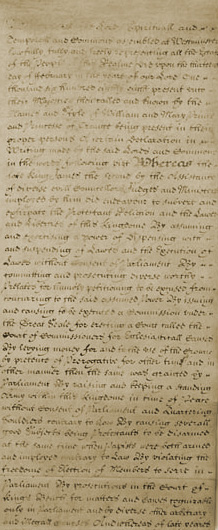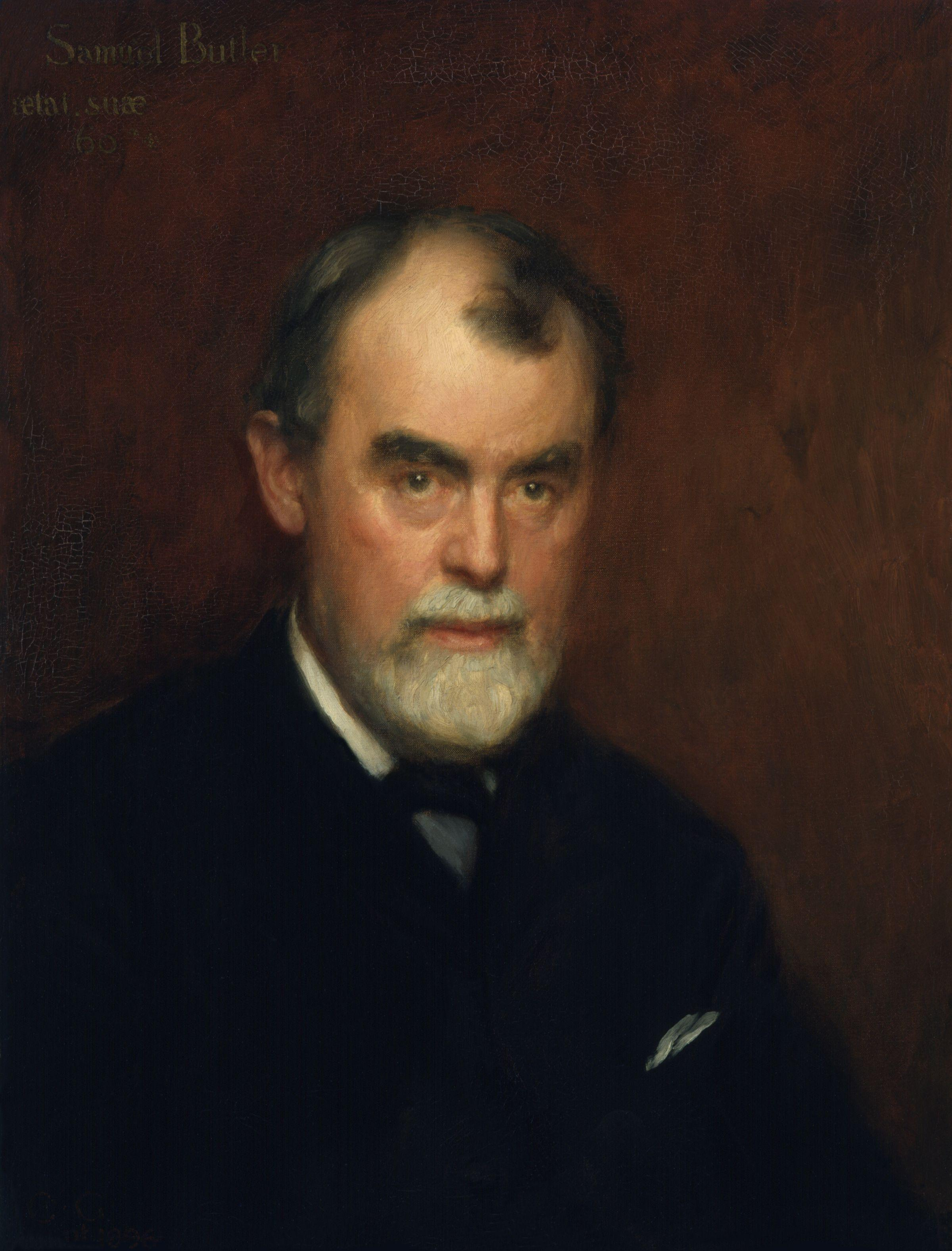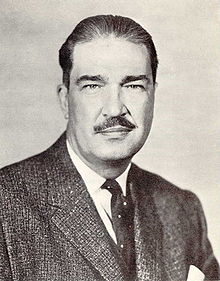(an interview with Pierce)

“And, yes, they [the Jews] deserve a great deal of blame.
But not all the blame. Perhaps not even most of it.”
—William Pierce (see below)
November 7, 1992
Kevin Alfred Strom: With the excitement of the election behind us now, what do you see ahead for Americans during the next four years?
William L. Pierce: More of the same.
KAS: You mean you think the recession will continue?
WLP: Actually, I didn’t mean that. I meant that America will remain on the same downward course she’s been on since the Second World War. I can’t predict the little ups and downs of the economy. But I can predict that, so long as certain very fundamental flaws remain in our society, we will continue going from bad to worse, in the long run. Whether the so-called “economic indicators” that the government publishes go up or down, whether we temporarily pull out of the present recession or not, economic life for the average White American will become bleaker in the years ahead. Worse, his social life will become more sterile, his cultural life more debased. Worst of all, his spiritual life, his view of his own meaning and purpose, will continue to shrivel.
KAS: My, you’re not very positive today, are you? Can you explain your gloomy prediction for us? Can you tell us just what you mean, can you give us the details, when you say that life for White Americans will continue to become worse? In what way will the economy become worse, for example?
WLP: The economy will become worse in that the average White family will work longer and harder for a smaller reward, for fewer of the necessities of life, for less security, for a meaner life style than before. The average standard of living, in other words, will continue to decline, just as it has in during the past few years. And this is something which absolutely did not depend on the outcome of the recent election. Both Clinton and Bush have been supporters of globalizing the US economy. They both have been boosters of the New World Order, in other words. They both support the removal of trade barriers with Mexico, for example, which will accelerate the export of American industry and American jobs to Mexico, simply because wages are much lower there. The effect of this, of course, will be gradually to raise wages in Mexico, while they are pulled down in the United States.
But, then, that’s the whole rationale behind the push for globalization, the push for the New World Order, isn’t it? Equalize living standards around the world. Lift up the poor non-Whites in the Third World and drag down the rich Whites. Give everyone a fair share of industry and the wealth which goes with it. Break down national and racial barriers. Homogenize the world, economically, racially, culturally. That’s the idea which has been pushed inexorably and unceasingly by the controlled media ever since the Second World War. The controlled media have made this idea of globalization fashionable; they’ve made it a Politically Correct idea, and therefore no one in the controlled political establishment in this country, whether Democrat or Republican, dares oppose it.
KAS: So it’s this bipartisan push for a global economy which leads you to predict that the US economy will continue to decline, no matter which party is in the White House?
WLP: That’s one of the reasons, and it’s an important reason, but there are also others. There is the continuing, unchecked flood of non-White immigration into America, for example. There’s the continued policy of favoritism shown to non-Whites in university admissions, in the awarding of scholarships, in hiring, and in promotions. And there’s the growing burden of supporting an unproductive and largely non-White welfare class. All of these reasons for future economic decline are thoroughly entrenched, they’re long-term, and they’re bipartisan reasons.
Which is to say that they’re Politically Correct, and so neither the Democrats nor the Republicans dare do anything about them. Can you imagine either a Democrat or a Republican proposing that we cut off all non-White immigration into the United States and try to restore America as a White country? Can you imagine one of them proposing that the government should no longer provide any support to the millions of inner-city residents now on welfare and should use all necessary force to maintain order if they don’t like it? There’s no more chance of that than there is of either a Democrat or a Republican President announcing that the New World Order is a scheme intended to reduce the White American worker to the same level as the Mexican peon and the Chinese coolie and that we’ll have no part of it.
And because there’s simply no chance that the controlled political establishment in this country, Democrat or Republican, will address or even admit the existence of the fundamental reasons for the declining living standard of Americans, I can predict with complete confidence that the economy will continue to decline, over the long run. There are various paper-shuffling tricks, of course—fiddling with interest rates, changing the tax structure, rearranging the Federal budget—which can make temporary changes in the economy, apparent changes, but they can’t cure this country’s real economic problems.
KAS: That’s interesting. But you know, the so-called economic “experts” that we hear on the controlled media disagree with you completely. They tell us that this recession is just a little anomaly, a little readjustment, and that over the long run everything is rosy. They say that the globalization of our economy is helping America by allowing us to export more of our products. They say that non-White immigration is boosting our economy by providing us with needed skills and eager workers. Here’s a recent issue of Business Week. The headline on the cover says, “The immigrants: how they’re helping the U.S. economy.” Are the media experts wrong?
WLP: Yes, they’re wrong, and what’s worse they know they’re wrong. They’re deliberately lying to us, deliberately misleading us, just as much as the politicians are. It doesn’t take a genius to see what’s happened to the economy of this country since the Second World War. The experts rave about the benefits the new World Order is bringing to us by allowing us to increase our exports. But the cold, hard reality is that globalization has brought us an enormous trade deficit.
The fact is that it has wiped out whole industries in this country and exported them overseas: the consumer electronics industry, for example, or the machine tool industry. The fact, not the theory, is that millions of Americans are being forced to switch from high-paying jobs in manufacturing and basic industry to low-paying service jobs. The fact is that before the Second World War most American families needed only one wage earner to keep them comfortable and secure; wives and mothers could stay at home and take care of their families. Today, of course, most mothers have to work outside the home. The fact is that our economy isn’t getting better and better; it’s actually getting sicker and sicker.
KAS: You keep referring to the changes which have taken place in the economy since the Second World War. Why is that? What does the war have to do with it?
WLP: The Second World War really has everything to do with it. It was, after all, an ideological war, one could almost say a religious war, a war between two fundamentally different world views.
On one side were the believers in quality over quantity, the elitists, the believers that White people, Europeans, are more progressive, are better able to maintain and advance civilization, and should hold onto their position of world mastery.
On the other side were the believers in quantity over quality, the egalitarians, the believers in racial and cultural equality, the people who thought it was wicked for the United States to remain a White country, wicked for White Britain to have a world empire, wicked for White Germany to be allowed to smash communism, wicked to permit nationalism to triumph over internationalism. And the fact is that the egalitarians won the war. After the Second World War White Americans could no more justify keeping hordes of hungry, non-White immigrants out of their country than Englishmen could justify hanging onto the British Empire. They had cut the moral ground right out from under themselves.
KAS: Of course, that’s not the way it was presented to Americans back in the 1940s. We were all taught that we went to war to keep America free, that we were fighting against tyranny, that we were fighting on the side of decency and justice.
WLP: Nonsense. We were fighting on the side of the folks who marched the entire leadership stratum of the Polish nation into the woods and murdered them. And the people who control our news and entertainment media knew that too. When the German Army discovered those huge pits full of murdered Polish officers and intellectuals, they called in the world press to look at the evidence. But the controlled media kept it quiet, so that we would keep fighting on the side of the murderers.
After the war they blamed it on the Germans. And there was nary a squawk from the controlled media when we turned the surviving Poles, and the Hungarians, and the Balts, and all the rest of the Eastern Europeans over to the same gang of cutthroats who had butchered Poland’s leaders in 1940. Of course, it made sense in a sick sort of way. After all, murdering a nation’s elite is an egalitarian act. After you kill off the most intelligent, the most able members of a nation the ones who’re left will be more nearly equal.
KAS: And easier to control.
WLP: Yes. But the point is that, the reasons given to the American people for getting into the war against Germany were all spurious. It was not a war to keep America free. Americans weren’t in the slightest danger of losing their freedom to the Germans. It was, as I said, an ideological war. It was a war about what kind of ideas would govern the world. It was a war about whether we would be proud and White and strong, or whether we would feel guilty about the fact that Mexican peons aren’t as well off as we are. And we lost the war. That was a real turning point in the fortunes of our race and our nation.
The loss of the Second World War is the real reason for the decline of the U.S. economy—and of our social life, our cultural life, and our spiritual life. Before the war we had a White country, a country determined to stay White. After the war we no longer had that determination. Instead we had the vague feeling that it was wrong of us to want to stay White. After the war when the controlled media began pushing for so-called “civil rights” laws and for opening our borders to the Third World, it was just a continuation of their push to get us into the war on the side of the people who had made Poland a more “equal” country by slaughtering her leaders at the killing pits in the Katyn woods.
We don’t really have time today to trace the whole process of the breakdown of America after the war, but we can look at a few examples which more or less tell the story. We’ve been talking about the economy, but it’s really our whole society which has been corrupted by the war, by the ideology for which the war was fought. Think, for example, about what life is becoming for the millions of White Americans who still live in our cities, especially those cities with a large minority contingent. We are no longer the masters in our own land, and we are paying the price for that decline in status.
Crime has soared enormously in our cities and made life a daily nightmare for millions who cannot move away. Even for those who live in the suburbs and only must work in the cities during the day, crime has become an ever-present constraint, a burden, a limit to their lives. City streets which once were safe for White women and men, by night as well as by day, are now like minefields where we must proceed with caution and be always on guard.
We know who makes our streets unsafe. We know against whom we are obliged to bar our windows. We know whom we must fear if our cars run out of gas or break down at night. And these are the same people whose welfare support imposes such an intolerable burden on our strained economy. And it is interesting that the government cannot solve our crime problem for exactly the same reason that it cannot solve our economic problem: it cannot address the causes; it cannot even admit the existence of the causes, because those causes are Politically Incorrect.
Just as the government economists talk about interest rates and budget adjustments but dare not speak of the effects of globalism on our economy, the sociologists talk about “poverty” as the cause of urban crime, but dare not mention that crime in America today is above all else a racial problem. Or look at what our schools have become, or look at popular entertainment. You know what the purpose of a school should be?
It should be not just to pound facts into the heads of children so they can earn a living; it should be to mold them into good citizens. It should be to teach them about their roots, about their ancestors, about their race. It should be to give them a sense of identity, a feeling of solidarity with their people, a feeling of appreciation for the civilization which their people created. It should be to teach them the values and customs which are peculiar to their people.
But most of the schools in America’s cities cannot do these things. They are not even permitted to try to do these things, because these things are all profoundly racist, the controlled media tell us. The only kind of school which can teach meaningfully about roots and identity is a school which is racially homogeneous, but such schools were outlawed by our government after the Second World War, because they are contrary to the principles for which that war was fought.
When our kids turn to drugs today, when they learn anti-White rap lyrics from the television, when they think Magic Johnson is a hero and say upon meeting a friend, “hey, man, gimme five,” we’re paying the price of the war. I said a few minutes ago that the worst aspect of the breakdown of America was not what’s happened to our economy, but what’s happened to our spiritual life, to our morale, to our idealism, to our character. White Americans haven’t become more stupid in the last fifty years. Most of the people listening to this program understand exactly what I’m saying. They didn’t really need me to point it out to them. They can see it for themselves. It doesn’t take a genius to understand why our schools aren’t working or why the New World Order will hurt Americans as the price of making Mexicans and Chinese more prosperous.
But it does take just a tiny bit of courage to stand up and say these things when we’ve had it drummed into our heads that we always must be Politically Correct. The people listening to this program have for years been watching America being torn down. They have seen the effects of egalitarianism, of liberalism on our society. They have seen one liberal program after another make things worse and worse, and they have listened to the controlled media and the controlled politicians tell them that what’s needed to fix things is more of the same. And they’ve thought to themselves, this is crazy.
But they’ve been afraid to say that out loud. They’ve been afraid to say, “Hey, look, Joe, the emperor doesn’t have any clothes on.” And it’s my considered opinion that this timidity, this willingness to go along with every new insanity imposed on us by the media and the politicians, even when we know it’s unnatural and immoral and destructive of everything worthwhile—this is a spiritual failure. This spiritual failure, this willingness to tolerate evil, is a more serious matter, in my eyes, than our economic decline. When we are able to heal ourselves spiritually, we’ll be able to heal ourselves economically and socially, but not before.
KAS: Is this spiritual failure entirely the fault of the American people? You’ve repeatedly referred to the controlled media as the principal promoters of the ideology which is at the root of our problems. Aren’t they to blame? Aren’t the people who control the media responsible for what’s happening to America? And, by the way, who are these media controllers?
WLP: Well, I think we all know who wields more control over the news and entertainment media than any other group. It’s the Jews. And, yes, they deserve a great deal of blame. But not all the blame. Perhaps not even most of it. After all, they’re only acting in accord with their nature. They’re doing what they always do when they come into a country.
We shouldn’t have let them do it. We should have stopped them when they were taking over Hollywood 75 years ago. We should have stopped them when they began buying up newspapers back before the Second World War. After the war we shouldn’t have let them get anywhere near a television studio. But we didn’t stop them, and the blame for that really lies with those who have set themselves up as our political leaders. They sold us out. They sold out America. They sold out their race. When our kids are exposed to the godawful, anti-White rap musicals from MTV, should we blame the Jewish owner of MTV, Mr Redstone, or should we blame the politicians in Washington who let him get away with it? Personally, I’d go after the politicians first.
KAS: I see your point. Tell us, Dr Pierce, do you think there’s any hope that White Americans ever will go after the politicians who are betraying them? Do you think they ever will regain enough spiritual strength to stand up and say, “Hey, the emperor is naked”?
WLP: I do. I believe that one day they’ll be shouting it from the housetops. More people are angry today about what their government is doing to America than at any time since the Second World War.
As time passes their numbers and their anger will grow. That is inevitable, because the policies of the controlled media and the government are making America an unlivable place.
The condition of the economy helps too. I would really be worried if I thought that the politicians could patch up the economy enough to lull people back to sleep. But I know that they can’t. I know that conditions can only become worse and worse under the policies which come from Washington, regardless of who’s in the White House. And this is what gives me hope for the future. When the pain becomes great enough, anger and frustration will overcome the fear of being Politically Incorrect, even for the most timid White American.







